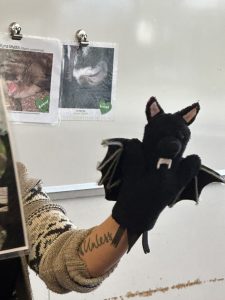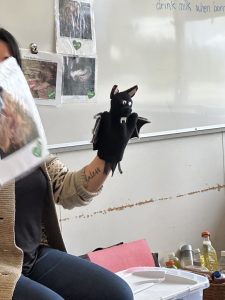BATS– We had a coordinator from the Douglas College Institute of Urban Ecology come to our classroom on November 20. Her name was Naomi. She introduced us to bat anatomy and adaptations, common bat myths and she talked about different species of bats. Bats are nocturnal and they are the only mammals that can fly. They emit ultrasonic bat calls called echolocation. One bat in BC, the Little Brown Bat, is an endangered species and we learned that they are important to our ecosystem and must be saved. Bats can eat around 1000-1200 mosquitoes in one hour! Bats also help with pollinating plants and dispersing seeds. We learned that vampire bats don’t actually suck blood and they definitely don’t drink the blood of humans. Vampire bats prefer large animals, like cows and horses, and they scratch the back leg area of these animals to create a cut, then they lick the blood as it drips out. This does not affect the cows or horses and most don’t even notice. To finish off the lesson, the students were able to make their own Little Brown Bat.












Alpha Leadership Gingerbread Houses! – Once again we were lucky to have the Leadership students from Alpha come to our classroom! This time they helped us create gingerbread houses and decorate the houses! We had a lot of fun again with these students and learned some patience and perseverance as some of the houses fell down and were challenging to make sturdy. This challenge helped to develop students’ Critical Thinking skills, one of our Core Competencies. Each student was able to create their own house in a style they chose. The candies you sent in were the finishing touch! The best part was probably getting to eat them at home!


















All of the students were very focused and engaged during this activity! They demonstrated teamwork and kindness as some students shared candy to get more variety for the decorating!













SCIENCE – HEAT TRANSFER– We learned about how heat transfers from hot things to cold things and we felt a delicious way to demonstrate this was by putting cold pizza into a hot oven to see if, indeed, the heat transferred from the oven to the pizza. We also learned that this form of heat transfer is a form of CONDUCTION (transfer of heat energy through direct contact…the oven rack) and CONVECTION ( transfer of heat energy through gas or liquid…in this case the air (gas) in the oven). The students were able to make either a cheese pizza or a pepperoni pizza. The final product was truly delicious! We love science!






